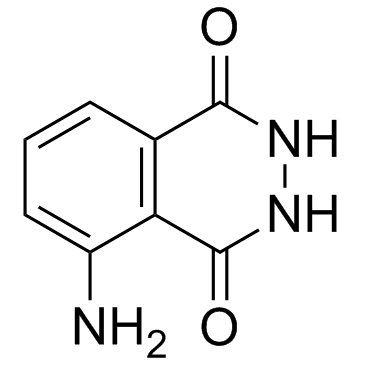Luminol

Luminol structure
|
Common Name | Luminol | ||
|---|---|---|---|---|
| CAS Number | 521-31-3 | Molecular Weight | 177.160 | |
| Density | 1.4±0.1 g/cm3 | Boiling Point | 621.9ºC at 760 mmHg | |
| Molecular Formula | C8H7N3O2 | Melting Point | >300 °C(lit.) | |
| MSDS | Chinese USA | Flash Point | 329.9ºC | |
|
Salicylic acid regulates Arabidopsis microbial pattern receptor kinase levels and signaling.
Plant Cell 26(10) , 4171-87, (2014) In Arabidopsis thaliana, responses to pathogen-associated molecular patterns (PAMPs) are mediated by cell surface pattern recognition receptors (PRRs) and include the accumulation of reactive oxygen species, callose deposition in the cell wall, and the genera... |
|
|
H89 enhances the sensitivity of cancer cells to glyceryl trinitrate through a purinergic receptor-dependent pathway.
Oncotarget 6(9) , 6877-86, (2015) High doses of the organic nitrate glyceryl trinitrate (GTN), a nitric oxide (NO) donor, are known to trigger apoptosis in human cancer cells. Here, we show that such a cytotoxic effect can be obtained with subtoxic concentrations of GTN when combined with H89... |
|
|
Changing the paradigm for myoglobin: a novel link between lipids and myoglobin.
J. Appl. Physiol. 117(3) , 307-15, (2014) Myoglobin (Mb) is an oxygen-binding muscular hemeprotein regulated via Ca(2+)-signaling pathways involving calcineurin (CN), with Mb increases attributed to hypoxia, exercise, and nitric oxide. Here, we show a link between lipid supplementation and increased ... |
|
|
Mycobacterial membrane vesicles administered systemically in mice induce a protective immune response to surface compartments of Mycobacterium tuberculosis.
MBio 5(5) , e01921-14, (2014) Pathogenic and nonpathogenic species of bacteria and fungi release membrane vesicles (MV), containing proteins, polysaccharides, and lipids, into the extracellular milieu. Previously, we demonstrated that several mycobacterial species, including bacillus Calm... |
|
|
Systematic comparison of the effects of alpha-synuclein mutations on its oligomerization and aggregation.
PLoS Genet. 10(11) , e1004741, (2014) Aggregation of alpha-synuclein (ASYN) in Lewy bodies and Lewy neurites is the typical pathological hallmark of Parkinson's disease (PD) and other synucleinopathies. Furthermore, mutations in the gene encoding for ASYN are associated with familial and sporadic... |
|
|
ALD1 Regulates Basal Immune Components and Early Inducible Defense Responses in Arabidopsis.
Mol. Plant Microbe Interact. 28(4) , 455-66, (2015) Robust immunity requires basal defense machinery to mediate timely responses and feedback cycles to amplify defenses against potentially spreading infections. AGD2-LIKE DEFENSE RESPONSE PROTEIN 1 (ALD1) is needed for the accumulation of the plant defense sign... |
|
|
Kuwanon V inhibits proliferation, promotes cell survival and increases neurogenesis of neural stem cells.
PLoS ONE 10(2) , e0118188, (2015) Neural stem cells (NSCs) have the ability to proliferate and differentiate into neurons and glia. Regulation of NSC fate by small molecules is important for the generation of a certain type of cell. The identification of small molecules that can induce new ne... |
|
|
Inhibition of CD40-induced N-Ras activation reduces leishmania major infection.
J. Immunol. 194(8) , 3852-60, (2015) Leishmania major is a parasite that resides and replicates in macrophages. We previously showed that the parasite enhanced CD40-induced Raf-MEK-ERK signaling but inhibited PI3K-MKK-p38MAPK signaling to proleishmanial effects. As Raf and PI3K have a Ras-bindin... |
|
|
Effects of pentylenetetrazole kindling on mitogen-activated protein kinases levels in neocortex and hippocampus of mice.
Neurochem. Res. 39(12) , 2492-500, (2014) The epileptogenesis process involves cell signaling events associated with neuroplasticity. The mitogen-activated protein kinases (MAPKs) integrate signals originating from a variety of extracellular stimuli and may regulate cell differentiation, survival, ce... |
|
|
Synergism of arsenic trioxide and MG132 in Raji cells attained by targeting BNIP3, autophagy, and mitochondria with low doses of valproic acid and vincristine.
Eur. J. Cancer 50(18) , 3243-61, (2014) We previously demonstrated that arsenic trioxide (ATO) and proteasome inhibitor MG132 synergistically induced cell death in promonocytic leukaemia cell line U937 but were antagonistic in Burkitt's lymphoma cell line Raji. Here we explore the role of autophagy... |